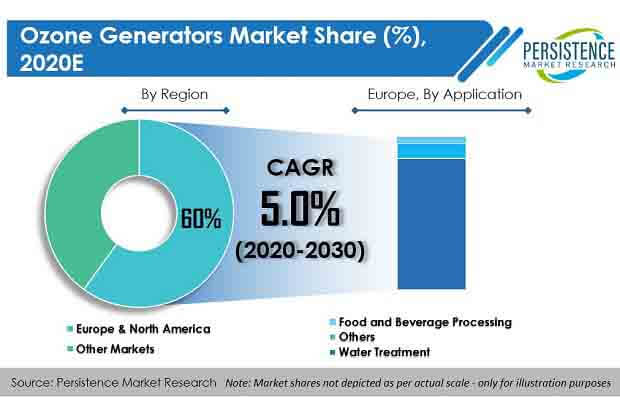Ozone Generators Market Segmented By Corona Discharge, UV Radiation Production Method for Water Treatment Food and Beverages Processing
Industry: Industrial Automation
Published Date: August-2020
Format: PPT*, PDF, EXCEL
Delivery Timelines: Contact Sales
Number of Pages: 300
Report ID: PMRREP22006
Ozone is one of the strongest oxidizing agents, owing to which, it is utilized in purification processes. Ozone is produced by two methods - UV radiation and corona discharge with electrical charge by ozone generators. These generators are capable of producing ozone in amounts ranging from a few milligrams to hundreds of kilograms.
The type and capacity of ozone generator depends on a number of factors, such as ozone concentration, running time, kind of water treated, ozone dosage, etc. The primary applications of ozone generators are water treatment and air purification across end-use industries. Moreover, ozone generators are also used in food & beverages processing and chemical industries for purification.
In chemical industries, ozone generators reduce energy during the bleaching process without using heat, by eliminating chemical use, thus reducing the amount of time needed to carry out the entire process. All these factors bode well for the expansion of the ozone generators market size over the forecast period of 2020 to 2030.
Ozone to Be Used as Effective Alternative for Chlorine, Thus Pushing Use of Ozone Generators: Conventionally, chemical methods such as chlorination were majorly used for water disinfection. However, use of such chemicals has posed a number of health- and environment-related risks, as these chemicals produce harmful byproducts such as trihalomethanes, amongst others.
Use of chlorine has numerous disadvantages, such as: Injection level - It is hard to maintain the level of chlorine in water; chlorine leaves harmful byproducts and a characteristic smell; and chlorine is more expensive than ozone generators.
Ozone, on the other hand, can be injected in adequate amounts with proper installation. Moreover, when it comes to disinfection, ozone is considered to be 3,000 times more effective than chlorine. As a result, the growth in adoption of ozone generators is expected, owing to growing awareness among people about the benefits of ozone.
Also, increasing regulations by environmental agencies such as EPA to monitor the maximum allowable limit for disinfection by products, will, in turn, drive the growth of the ozone generators market in the coming years.
Growing Use of Ozone Generators for Non-conventional Applications: Earlier, the use of ozone generators was limited to water treatment and waste water treatment. However, lately, ozone generators are being widely used for non-conventional applications; for instance, to improve the performance of extrusion coatings. Adding ozone to the process allows for lower extrudate temperatures, thus allowing the use of lower temperature resins (EVAs).
Ozone can improve various properties such as bonding characteristics, heat sealability, color, and odor, thereby adding to the product value. Moreover, ozone is also used for pulp bleaching, and has replaced the conventionally used chlorine dioxide.
The use of ozone has also led to a significant reduction in bleaching costs. Additionally, dissolved ozone is also used in semiconductor cleaning applications (wafer-cleaning and resist-stripping applications), and is used as an effective alternative to sulfuric acid. As such, the global ozone generators market is projected to experience steady growth over the coming years.

Europe and North America hold leading ozone generators market shares. Both these regions are projected to account for 60% of the market share in 2020. The rest of the world, combined, will hold a market share of the remaining 40% in 2020.
With the COVID-19 crisis showing no signs of slowing down, industries and economies across the world have been adversely affected, besides trade and import-export. With reduced activity across end-use industries, the demand for ozone generators has drastically fallen in 2020. Growth of the global ozone generators market will pick pace with the opening up of industries as the virus is brought under control.
As per analysis done by PMR, the global ozone generators market is slated to expand at a steady CAGR of 5% over the forecast period of 2020 to 2030. Market players can look to Europe and North America for the most lucrative opportunities and profits. Demand for application of ozone generators in water treatment will be the highest through 2030.
PMR’s study on the ozone generators market is divided into four significant segments – capacity, production, application, and region. This report offers comprehensive data and information about the important market dynamics and growth parameters related to these categories.
| Attribute | Details |
|---|---|
|
Capacity |
|
|
Production |
|
|
Application |
|
|
Region |
|
To know more about delivery timeline for this report Contact Sales
